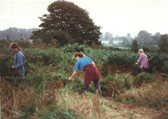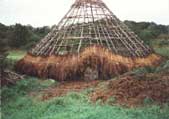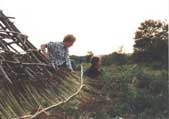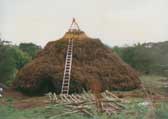First Roundhouse: Thatch
We thatched the roof with bracken, which is from the Fern family. It might sound like a strange choice, not one usually associated with thatching. The most commonly used thatching materials in Britain are reeds or wheat straw, but for us, the convenience and economic advantages of an adjoining piece of common land covered with 5-6 foot tall bracken was too much of a temptation to resist.
We believe bracken has the potential to be a great thatch (correct me if I'm wrong) for it kept us dry for nearly four years, and we only had a rudimentary grasp of thatching at the time.
Because we wanted the greatest length of bracken stalk, we opted for pulling the bracken by hand, rhizome (root) and all. Before beginning to thatch we had heard that the rhizome - being the hardest part of the plant - should face out. However having experimented and had problems with this method, we decided on the opposite, the bracken could be bundled and then laid upside down.
The bundles, 3 - 4 inches thick and tied with sisal twine, were laid onto the lowest purlins in two-foot long blocks. A long piece of hazel was tied to the purlin and the thatch was trapped between the two. Having laid two feet the hazel batten was tied to the purlin again, while pushing the bracken down and across, against the previous knot. This process was repeated along the entire circumference of the house, until the two ends met. We then started on the second purlin, and this time we had to lay bundles on top of the stalks of the lower course of bundles.
This has to be the easiest way to thatch a roof, but there is one drawback, which is tying all those knots (especially with sisal, which is less than friendly to the hands.) If this is to be attempted, we recommend good gloves, and a stout knee-pad to press down on the battens to aid with tying.
In terms of performance, the bracken behaved admirably. When we de-thatched the Roundhouse prior to its dismantling, we were amazed at the quality of preservation. The smoke from the fire had cured the bracken and on the very outside, the foliage of the stalks had rotted to form a slimy layer which is perfect for water run-off. We'd recommend bracken as a free alternative to wheat or reed thatch to anyone.
3 important points: Bracken can cut your hands, so wear gloves. Try to pick the bracken before the spores are released because these can be dangerous to health. Long trousers are safer than shorts, as bracken tends to house ticks, which can burrow into unprotected legs.
Home | News
| First Roundhouse | New
Roundhouse |Gallery Index
The Project | Resources
| Contact | Help
All content: © The Roundhouse Project 1997-2010






